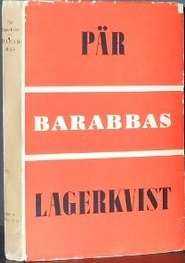Barabbas (novel)
 First edition | |
| Author | Pär Lagerkvist |
|---|---|
| Translator | Alan Blair |
| Country | Sweden |
| Language | Swedish |
| Genre | Historical novel |
| Publisher | Albert Bonniers förlag |
Publication date | 1950 |
| Media type | Print (Hardback & Paperback) |
| Pages | 144 |
| ISBN | 0-7011-0879-7 |
Barabbas is a 1950 novel by Pär Lagerkvist. It tells a version of the life of Barabbas, the man whom the Bible relates was released instead of Jesus. The novel is built on antithesis: Jesus dies first among the three crucified – Barabbas dies last. Jesus dies among several of his friends – Barabbas dies alone. Jesus talks to God – Barabbas talks to the darkness. The novel starts with Jesus' crucifixion and ends with Barabbas' crucifixion in Rome.
Plot
Jesus is crucified on Mount Golgotha. To the side of the crowd stands Barabbas. A violent man, a brigand, and a rebel, he cannot muster much respect for the resignation of the man who died in his place. He is skeptical about the holiness of Jesus, but he is also fascinated by the sacrifice and he seeks out the different followers of Jesus trying to understand, but finds that their exalted views of Jesus do not match his down-to-earth observation of the man. More important, since Barabbas has never been the recipient of love (the cornerstone of the Christian faith), he finds that he is unable to understand love and hence unable to understand the Christian faith. He says that he "Wants to believe," but for Barabbas, understanding is a prerequisite for belief, so he is unable.
Enslaved, shackled to another named Sahak, and condemned to work in the notoriously life-shortening and infernal copper mines of ancient Rome, Barabbas has an extraordinary crisis of faith, the exact nature of which is elucidated in the final portion of the novel. Barabbas' ultimate loyalties lie with the opaque, remorseless void that fed and surrounded his former life, manifested in the darkness of the night of his execution, which he surrenders himself to with his final breath.
Film and theatrical adaptations
- A Swedish film made in 1953 by Alf Sjöberg was entered in the Cannes Film Festival.
- The novel was turned into a film by Dino De Laurentiis in 1961, starring Anthony Quinn.
- A 2012 American-Italian television movie was directed by Roger Young.